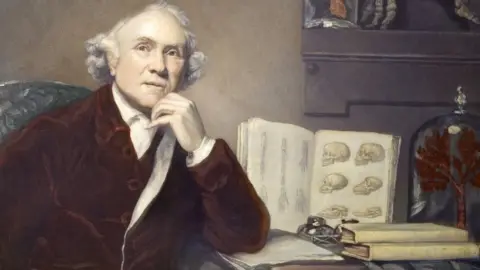The Irish Giant: Charles Byrne's skeleton removed from display
 BBC
BBCThe skeleton of an Irish giant is to be removed from display at a London museum due to "sensitivities".
Charles Byrne grew to be 7ft 6in (2.3m) and his bones have been on public display for more than two centuries at the Hunterian Museum.
Confirming the news, the museum said the skeleton would remain available for "bona fide medical research".
Despite calls for repatriation of the remains, distant relatives of Byrne have supported continued research.
Brendan Holland, whose family share a common ancestor with the Byrne family going back 1,500 years has said the skeleton should continue to "benefit the living".
Byrne was born Charles O'Brien in mid Ulster in 1761.
By 1782, his height meant he was one of London's greatest celebrities, being paid to entertain audiences by displaying his body under the stage name of Charles Byrne.
He had an undiagnosed benign tumour of his pituitary gland, an adenoma, which caused acromegaly and gigantism.
 Science Photo Library
Science Photo LibraryIn June 1783, at just 22 years old, he said he wanted to be buried at sea supposedly to prevent his body being seized by anatomists.
John Hunter was known for collecting and displaying unique specimens for his museum and paid Byrne's friends to hand over his body.
Ethical questions about the display of the remains have been raised many times and there have been frequent calls for the skeleton to be sent to mid Ulster, or for burial at sea.
The late Dame Hilary Mantel, who published a fictionalised account of Byrne's life told the Guardian in 2020: "It's time Charles went home."
"I think that science has learned all it can from the bones, and the honourable thing now is lay him to rest," she said.
Brendan Holland was always tall and in 1972 at the age of 20 reached 6ft 9-and-a-half inches (2.06m) in height.
That same year, the cause of this was found to be a benign tumour in his brain meaning his pituitary gland was producing too much growth hormone and it was life-threatening.
Radiation treatment meant he stopped growing at 6ft 10-and-a-half inches (2.08m).
Almost four decades later Dr Márta Korbonits, a world-leading expert in growth hormone conditions, had been working with O'Brien's DNA and believed both of them had grown so tall because of a "rogue" gene which had mutated.
Subsequent tests proved the O'Brien family and the Holland family shared a common ancestor.
'Benefitting the living'
Speaking to BBC NI, Mr Holland said that although there was a debate over whether the skeleton should be on public display he was in favour of it being available for medical and teaching purposes.
"It has benefitted the living, those with the condition now know why they have it and how to treat it, I think if he was alive he would concur with it as it can be life threatening.
"You have to remember, this was a man living in 18th century London coming from a rural Irish background where he spent the first 19 years of his life, he would not know the nature of his condition or be that well informed."
According to Mr Holland , one of Charles' biggest fears was being dissected as those who were usually dissected were criminals and Charles had pride in his standing.
Now 70years old, Mr Holland believes he is the oldest living person with the condition and puts this down to the advances in medicine and treatment.
"When you get down to the nuts and bolts, the primary reason it's on display in the museum is to illustrate what gigantism can do, the extreme effects on the bone structure and frame", he said.
"For those people who campaign for his burial or repatriation, I would caution them would they feel them same way if they had gigantism?"
